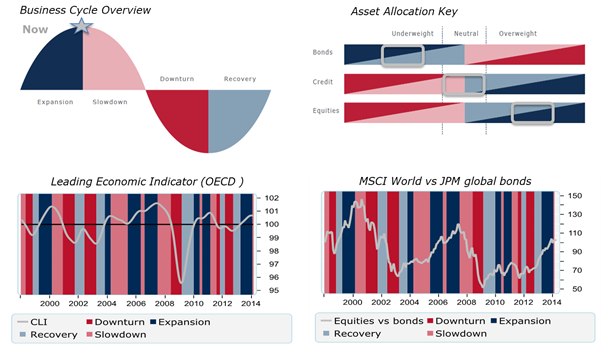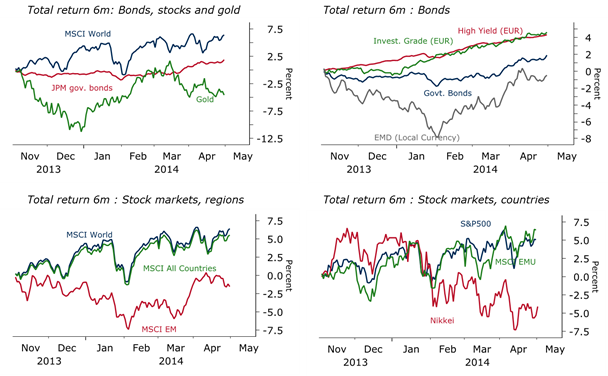Global equities rose by 0.7 percent in April, thus ending a choppy month with a small gain. Emerging markets lost ground again with a loss of 0.2 percent. However, what was perhaps most notable was a strong rotation out of sectors and styles that have gained substantially over the past year, particularly small cap and IT. Year-to- date, global equities have risen by 1.8 percent, equivalent to an annualised return of 5.5 percent. This is significantly less than the return on the same time last year but considering increasing economic as well as geopolitical uncertainty this year, the result must be viewed as acceptable. Furthermore, on the first day of May, MSCI World rose to a new all-time high, surpassing the previous peak from October 2007.
While stocks have been a volatile affair this year, the sustained decline in interest rates has been the cause of a more positive tone on the bond markets. German 10-year government bond yields have fallen from 1.95 percent at the beginning of the year to just 1.45 percent. Combined with a substantial decline in intra-euro yield spread, long-term Eurozone bonds have yielded as much as 5.7 percent so far this year (US 7-10 year bonds have returned 3.5 percent in 2014). Also, European corporate bonds have performed well this year, with returns of around 5 percent for both the investment grade and high-yield categories. As commodity prices have risen, all main asset classes have delivered positive returns this year.
Slowdown?
During the previous month, our economic model has shifted from an economic expansion to a slowdown (see here for details). The setback is modest and yet only visible on the second decimal but for the first time in 17 months the signal is now negative. The decline has largely been driven by the US which was adversely affected by extreme weather conditions during the winter. Recent indicators, including ISM, consumer confidence and non-farm payrolls suggest that we shall see a return to higher growth rates over the coming months. Unlike the US, Europe has maintained solid momentum in the first quarter. In general, I expect that this slowdown will be short-lived, in line with similar mid-cycle slowdowns in 2006 and 2010. I still consider the cyclical shift as important because, historically, there is a clear correlation between the business cycle and trends in the financial markets. Economic expansions, such as the one that just ended, are characterised by positive returns on equities in line with what we saw last year. Normally, the picture changes in a slowdown, and investors get no compensation for the increased risk in equities relative to bonds. Therefore, the financial returns this year correspond roughly to what can be expected in a slowdown. Interestingly, we often see new equity highs in the early stages of a slowdown followed by a more negative trend. Only in a genuine economic downturn does the expected return turn negative. Much will therefore depend on whether or not the current slowdown will be short and replaced by a renewed upswing or if we are moving toward a full-blown recession (which is not my main scenario).
Importantly, there is also a tendency for market corrections to be magnified during the negative parts of the business cycle. Last year, which saw an economic expansion, the deepest correction for global equities was the 8 percent decline from May to June. In 2012, the MSCI World Index fell by 13 percent in the second quarter, during the part of the cycle we call a downturn. In 2011, the market fell by 22 percent between May and September, in a combination of a slowdown and a downturn. Finally, MSCI World fell by 17 percent in 2010 between March and July during an economic slowdown. A long-term investor can often maintain an overweight of portfolio risk during a market correction in the positive part of the business cycle. In contrast, one should consider reducing in a slowdown, and equities should be underweight during a recession, or downturn.
Party like its 1996?
Global stock markets have risen considerably since the trough of March 2009 but in a longer perspective the rise does not seem alarming. Adjusted for inflation, the S&P500 has risen by 64 percent over the past decade. In contrast, the historical bull markets in the 1990s, in the 1950/60s and the 1920s all had all-rolling 10-year returns of more than 300 percent.
The current pricing of equity markets does not seem excessive, either. S&P500 trades at 15 times forecast earnings for the coming year. This is in line with the historical average, and also exactly at the level where the former Federal Reserve chief Alan Greenspan worried about "irrational exuberance " in 1996. Despite Greenspan’s concerns, the S&P500 rose by a further 110 percent over the next four years.
What Greenspan underestimated in 1996 was a strong economic tailwind that would end up lifting the stock market considerably. My contention is that the markets today have a lot in common with the markets in 1996. Just as in the mid-1990s, the Western economies are experiencing a sharp drop in inflation. Falling inflation means lower uncertainty about the future, and lower risk premiums on equities and other financial assets. Lower prices for food and energy also allows for a rise in disposable income for consumers and higher consumer confidence. The economic tailwind was supported by a marked improvement in public finances, which is repeated today. It is often overlooked that the United States has undergone a period of radical fiscal austerity that is now over. Low inflation and spare economic capacity, as well as a sound basis for public finances, point to the possibility of a sustained recovery in the coming years that could lift corporate earnings. It is also likely to lead to an increase in the PE multiple investors will be willing to pay for the same earnings . And just as in the mid-90s a technological revolution is running alongside us.
Quo vadis, Ukraine?
By far the largest uncertainty factor today is the tense situation in and around Ukraine. A presidential election is to be held on May 25 but, in reality, the country can be divided (again) before today. More problematic for global financial markets is the behaviour of the major powers. Currently, the endgame to the conflict for both the US and Russia seem somewhat unclear, and in both cases we must try to assess how far the parties are willing to go. If the goal of the US is a Russian power change leading to the ousting of President Putin, much along the lines of the strategy Washington has followed towards Iran for decades, a de-escalation seems remote. If the goal of Russia is a de-facto takeover of Ukraine (and other neighbouring countries) tensions are likely to rise. For Europe, the conflict is significant also in an economic sense, due partly to the reliance on energy imports from Russia and partly since close economic relations increases the risks of a negative economic outcome in the event of a worsening of the conflict.
Investment conclusions
The shift to a slowdown in our economic model is an important signal in terms of our tactical allocation, where I usually begin a reduction of portfolio risk. Since I expect this slowdown to be short-lived, I maintain an overweight of equities to bonds presently and also of high yield corporate bonds. My patience patience towards the re-establishment of an economic recovery is modest, however. The situation in and around Ukraine is, as mentioned, the primary risk factor in the short term. As often with geopolitical tensions, it is difficult to act before the event but the situation should be monitored closely. I remain underweight emerging markets.


